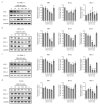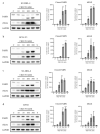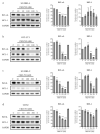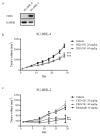Anti-Cancer Effects of CKD-581, a Potent Histone Deacetylase Inhibitor against Diffuse Large B-Cell Lymphoma
- PMID: 32575557
- PMCID: PMC7352247
- DOI: 10.3390/ijms21124377
Anti-Cancer Effects of CKD-581, a Potent Histone Deacetylase Inhibitor against Diffuse Large B-Cell Lymphoma
Abstract
Double-hit lymphoma (DHL) and double-expressor lymphoma (DEL) are aggressive forms of lymphoma that require better treatments to improve patient outcomes. CKD-581 is a new histone deacetylase (HDAC) inhibitor that exhibited a better safety profile in clinical trials compared to other HDAC inhibitors. Here, we demonstrate that CKD-581 inhibited the class I-II HDAC family via histone H3 and tubulin acetylation. CKD-581 treatment also up-regulated the phosphorylation of histone H2AX (γH2AX, DNA double-strand break marker), and reduced levels of MYC and anti-apoptotic proteins such as BCL-2, BCL-6, BCL-XL, and MCL-1 in DH/DE-diffuse large B cell lymphoma (DLBCL) cell lines. Ultimately, CKD-581 also induced apoptosis via poly(ADP ribose) polymerase 1 (PARP1) cleavage. In a DLBCL SCID mouse xenograft model, CKD-581 exhibited anti-cancer effects comparable with those of rituximab (CD20 mAb). Our findings suggest that CKD-581 could be a good candidate for the treatment of DLBCL.
Keywords: CKD-581; MYC; diffuse large B cell lymphoma; histone deacetylase inhibitor.
Conflict of interest statement
The authors declare no conflict of interest.
Figures





Similar articles
-
HDAC inhibitor chidamide synergizes with venetoclax to inhibit the growth of diffuse large B-cell lymphoma via down-regulation of MYC, BCL2, and TP53 expression.J Zhejiang Univ Sci B. 2022 Aug 15;23(8):666-681. doi: 10.1631/jzus.B2200016. J Zhejiang Univ Sci B. 2022. PMID: 35953760 Free PMC article.
-
A model of sensitivity and resistance to histone deacetylase inhibitors in diffuse large B cell lymphoma: Role of cyclin-dependent kinase inhibitors.Cancer Biol Ther. 2013 Oct 1;14(10):949-61. doi: 10.4161/cbt.25941. Epub 2013 Aug 2. Cancer Biol Ther. 2013. PMID: 23982416 Free PMC article.
-
The sensitivity of diffuse large B-cell lymphoma cell lines to histone deacetylase inhibitor-induced apoptosis is modulated by BCL-2 family protein activity.PLoS One. 2013 May 7;8(5):e62822. doi: 10.1371/journal.pone.0062822. Print 2013. PLoS One. 2013. PMID: 23667527 Free PMC article.
-
The Spectrum of MYC Alterations in Diffuse Large B-Cell Lymphoma.Acta Haematol. 2020;143(6):520-528. doi: 10.1159/000505892. Epub 2020 Feb 19. Acta Haematol. 2020. PMID: 32074595 Review.
-
Double-Hit Large B Cell Lymphoma.Curr Oncol Rep. 2017 Sep 26;19(11):74. doi: 10.1007/s11912-017-0629-y. Curr Oncol Rep. 2017. PMID: 28952038 Review.
Cited by
-
Preclinical Evaluation of the HDAC Inhibitor Chidamide in Transformed Follicular Lymphoma.Front Oncol. 2021 Dec 3;11:780118. doi: 10.3389/fonc.2021.780118. eCollection 2021. Front Oncol. 2021. PMID: 34926293 Free PMC article.
-
Epigenetic regulation in hematopoiesis and its implications in the targeted therapy of hematologic malignancies.Signal Transduct Target Ther. 2023 Feb 17;8(1):71. doi: 10.1038/s41392-023-01342-6. Signal Transduct Target Ther. 2023. PMID: 36797244 Free PMC article. Review.
-
Cellular senescence in cancer: molecular mechanisms and therapeutic targets.MedComm (2020). 2024 Apr 24;5(5):e542. doi: 10.1002/mco2.542. eCollection 2024 May. MedComm (2020). 2024. PMID: 38660685 Free PMC article. Review.
-
Chidamide represses MYC expression and might improve survival for patients with double expressor lymphoma.Am J Cancer Res. 2024 Jun 15;14(6):2921-2933. doi: 10.62347/GIIR3351. eCollection 2024. Am J Cancer Res. 2024. PMID: 39005667 Free PMC article.
-
Targeting MYC-driven lymphoma: lessons learned and future directions.Cancer Drug Resist. 2023 Apr 12;6(2):205-222. doi: 10.20517/cdr.2022.127. eCollection 2023. Cancer Drug Resist. 2023. PMID: 37457123 Free PMC article. Review.
References
-
- Hunt K.E., Reichard K.K. Diffuse large B-cell lymphoma. Arch. Pathol. Lab Med. 2008;132:118–124. - PubMed
-
- Molina T.J., Canioni D., Copie-Bergman C., Recher C., Briere J., Haioun C., Berger F., Ferme C., Copin M.C., Casasnovas O., et al. Young patients with non-germinal center B-cell-like diffuse large B-cell lymphoma benefit from intensified chemotherapy with ACVBP plus rituximab compared with CHOP plus rituximab: Analysis of data from the Groupe d’Etudes des Lymphomes de l’Adulte/lymphoma study association phase III trial LNH 03-2B. J. Clin. Oncol. 2014;32:3996–4003. - PubMed
MeSH terms
Substances
Grants and funding
LinkOut - more resources
Full Text Sources
Other Literature Sources
Research Materials
Miscellaneous

